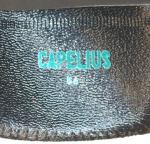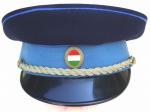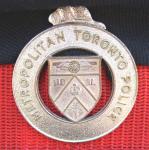-
Posts
13,225 -
Joined
-
Last visited
-
Days Won
22
Content Type
Profiles
Forums
Blogs
Gallery
Events
Store
Everything posted by Mervyn Mitton
-
The VC ranks at No.25 on the precedence list - then the GC ; the CGC; the DSO; Number 28 is the Imperial Service Order and Number 29 the Imperial Service medal.. No.32 is the DSC; 33, the MC; 34, the DFC.. The Military Medal is only at 55. I have never understood , either, how this low award is ranked so highly - I suppose it it because it is linked to the ISO ?
-
Megan - what a pleasant surprise finding you here..... However, the new books sound interesting and are badly needed. There will be two volumes and he is a reputable member of PICA (Police Insignia Collectors Association.) He is taking orders for - I think Sept. - and is quoting for both volumes £55($80) - which I think is reasonable. I have ordered a set.
-
Welcome to GMIC , Adrob. I see you are in Malta - are you in the Police ? I have seen the pictures of this helmet - the original owner sold it on ebay, so it has disappeared from sight. Many British helmet plates were black and as we said, the helmet may have been issued from one of the Services. Remember, that in the early 1900's the British made their own rules ! We still like to, but no-one listens today........ Try and get us some photos from the Police Museum - would be very interesting. Last time I was in Valetta I presented a copy of my book to the Commissioner. Don't think he gave me anything ! I always liked the Phoenicia Hotel - have they up-dated it yet ?
-
Hi - Darrell. Nice to see a good explanatory post to this - fairly rare medal. It is peculiar to Sth. Africa and the numbers are small. If I remember , in the low thousands for Basutoland (now Lesotho) and Bechuanaland (now Botswana) and only just over 700 for Transkei (which is in the Eastern Cape). They have gone-up in recent years and stand at about £200 ($300) - dependent on unit and rank. We have had them on GMIC in groups, but I think this may be the first single ? Have you been away ? Mervyn
-

PART 9 - POLICE FORCES OF THE WORLD
Mervyn Mitton replied to Mervyn Mitton's topic in Police Forces of the World
Thankyou Les. I will amend the 'index' page. I will also answer your queries on the other items in a day or, so. I would never have thought of Hungary - even more interesting. Still, this is what our Forums are about - shared knowledge and information. We still have about another 30 caps to post (as they arrive) - please don't let them stop other posts. The only reason I'm doing this is to make like a data bank for the future - members can add other info. at any time - but at least there will be a heading. -

Zulu items
Mervyn Mitton replied to helen's topic in Great Britain: Militaria: Badges, Uniforms & Equipment
Hi - Helen. An interesting subject and I liked your commentary. The weaving of baskets and the making of decorative objects from telephone wire has always been popular and being so malleable the craftsmen can create some lovely designs. However - and without being contentious - it was not telephone wire which started the idea. From recent years I would not disagree with the old telephone coloured wire being scavenged and used for the above purposes - however, the origins of the materials are from further back. Alfred Nobel registered blasting gelignite in the the 1870's and this allowed the gold mines to penetrate deeper and more safely. The expansion required large number of workers to live at the mines and they worked three shifts a day. Thousands of Zulus were recruited -along with people from other tribes - and all were required to live in barrack buildings. They actually had to leave their wives and families and were only allowed to return home for three or four weeks a year at the Christmas period, when the mines closed. Needless to say there were many problems for the men - drunkeness, violence between tribal groups and of course - total boredom. There was no entertainment and so many things started which have become, today, a way of life. Gumboot dancing is probably one of them - and for those skilled with their hands - they turned to making the woven baskets and other objects. Telephone wire would not have been available to them - but, they had the coloured fuse wire which the mines used to detonate the gelignite........ The earliest of these pieces , are therefore, made from detonation wire - not dis-similar to later telephone wire, which took over. They still use the fuse wire in the mines and I am sure it is still used - to a certain degree - for making baskets et.. -
INTRODUCTION : POLICE FORCES OF THE WORLD PART 1 : BELGIAN GENDARMERIE PART 2 : U.S. POLICE CAPS PART 3 : BRITISH HELMETS AND CAPS PART 4 : CAMBODIA - GENERAL'S CAP PART 5 : GERMAN POLICE CAPS PART 6 : ARGENTINA - SENIOR OFFICER'S CAP PART 7 : AUSTRIAN POLICE CAPS PART 8 : CANADA - TORONTO MUNICIPAL POLICE PART 9 : HUNGARIAN CAP PART 10 : FRANCE - KEPI
-

PART 10 - POLICE FORCES OF THE WORLD
Mervyn Mitton replied to Mervyn Mitton's topic in Police Forces of the World
-

PART 10 - POLICE FORCES OF THE WORLD
Mervyn Mitton replied to Mervyn Mitton's topic in Police Forces of the World
-
See intro. for add. info. we would like to add to these posts in the future. This cap is the French KEPI and possibly on a par with the British helmet for instant recognition. The number is either a district or, area(Department) - however, it will be good to have some expert comment. The Kepi is also worn by the Belgium Gendarmerie. Does the silver braid have any significance - i.e. for an N.C.O. or, officer ?
-

PART 9 - POLICE FORCES OF THE WORLD
Mervyn Mitton replied to Mervyn Mitton's topic in Police Forces of the World
-
This appears to be an Italian Police cap - perhaps a town force ? Please add as much info. as possible - see Intro. - World Police Forces
-

New firearms display at Pitt Rivers now open
Mervyn Mitton replied to helen's topic in Firearms & Ordnance
Welcome to the forum - at least you didn't have far to go to visit the museum. Whereabouts in Hampshire are you ? -

South African Naval Forces WWII history
Mervyn Mitton replied to Brett Hendey's topic in World War II 1939 to 1945
Thankyou, Brett. Sounds to be a worthwhile ref. book - and not expensive considering how book prices have risen. Mervyn -

Brooched military medal!
Mervyn Mitton replied to paddywhack's topic in Great Britain: Orders, Gallantry, Campaign Medals
When medals are mounted as a brooch or, as a neck pendant, it is a tragedy for the collector. However, the chances are that either he gave it to his wife as a gift - being his most important possession or, he was KIA and she had it mounted. I don't think it could ever be restored fully, so, keep it for what it is - a tribute to a brave man. Whilst it has some polishing it is crisp - but, look under the pin mount and there is a lot of wear. This is where it has rubbed - over the years - on her dress. I hope someone can help with his identity - do let us know ? -

Japanese Type 4 Ceramic Grenade 1944
Mervyn Mitton replied to Brian Wolfe's topic in Firearms & Ordnance
Like Hugh, I must admit that I have never heard of a ceramic grenade - Japanese or, otherwise. They would have tested them before issue , so, they must have been effective - in the end a lump of metal or , hardened clay is going to be just as dangerous. I agree with you about Mexico - why would they make copies of something that is quite rare - if anyone were do this, surely it would be the Japanese ? An unusual subject matter, Brian - a history of grenades would make a good post if someone had the time..... -
With older min. QSA's you will usually find that they are thicker and are of sterling silver. This will apply to many of the mins. in your general collection. These early ones are now quite hard to find and many on the market are of recent manufacture and cupro-nickel. The bars are all important and - as with full size - you will want to collect the different combinations. You have one King's South Africa medal - I am sure you will know that it couldn't be issued on it's own. So, better to put it with a QSA and make a pair. The two rare - and interesting medals are on the lower left. These are the Boere Oorlog medal - awarded in the 1920's by the Sth. African Govt. to Afrikaaner veterans of the Boer War (1899-1902). Only just over 12000 were issued and one doesn't see the miniatures very often as they didn't have the need to wear them in formal clothes. About £50 each ($75) Rands 550/600. An interesting fact with this medal is that the two sides of the medal have different Coats of Arms. One for the Orange Vrystaat and the other side for the South African Republic in the Transvaal. The ribbon is also for both states - if the Vrystaat arms are to the front - the ribbon is worn with the Yellow facing into the chest - and of course - vice-a-versa . Hope this helps - feel free to ask me any questions.
-

Len's Miniature Medal Collection
Mervyn Mitton replied to Len's topic in Great Britain: Orders, Gallantry, Campaign Medals
Hi - Len. Can't remember if we've spoken before - if not, welcome to GMIC. You have put together a good representation of the min. medals available. Ones like the DFC have become quite valuable and I can see several that would be sought after for collections. Try to get authenticated groups - they will always be worth more then the singles. Best wishes. Mervyn -

A VM as a brooch
Mervyn Mitton replied to Tony's topic in Great Britain: Orders, Gallantry, Campaign Medals
Hi - Tony. Makes a very interesting record of service - but, you have to wonder why he bothered. A man with mixed loyalties - perhaps he had a lot of girl-friends..... -

PART 8 - POLICE FORCES OF THE WORLD
Mervyn Mitton replied to Mervyn Mitton's topic in Police Forces of the World
-

PART 8 - POLICE FORCES OF THE WORLD
Mervyn Mitton replied to Mervyn Mitton's topic in Police Forces of the World










